Imagine walking into a living room that instantly makes you feel at home, stylish yet cozy — that’s the magic of inspired apartment living room ideas! These designs are incredibly popular because they allow you to maximize small spaces while showcasing your unique personality, making every inch count.
In this article, you’ll find a diverse range of ideas that blend comfort with style, from clever storage solutions to eye-catching decor tips. Whether you’re into modern minimalism, boho charm, or eclectic vibes, there’s something here to spark your creativity and transform your living space into a true reflection of you.
1. Cozy Nook with Multi-Functional Seating and Soft Textiles
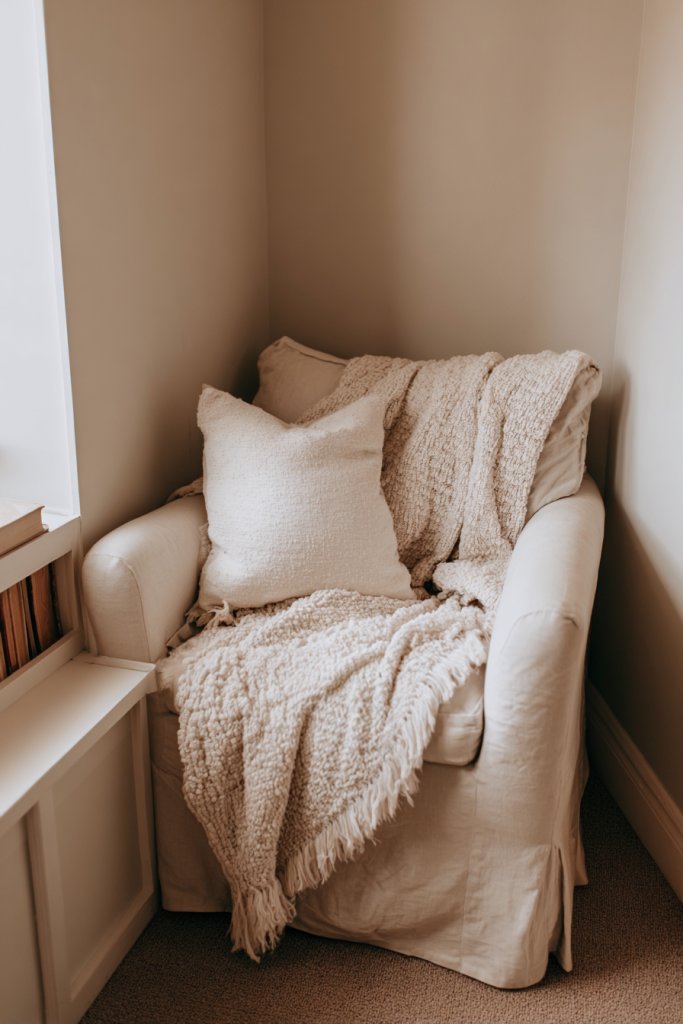
Ever feel like your living space is missing that cozy corner where you can unwind without feeling cramped? Creating a inviting nook offers a perfect escape while maximizing limited space. It’s about transforming a small area into a personal sanctuary of comfort. Who doesn’t want a little retreat amid the chaos of city living?
Imagine sinking into a plush armchair draped with a soft, textured throw, nestled beside a compact side table holding your favorite mug. Layered cushions with varying fabrics add tactile warmth, inviting you to relax. The cozy corner is illuminated softly by warm ambient lighting, creating an intimate glow. It’s a space that beckons you to unwind after a hectic day.
You can tailor this nook to your style—think Scandinavian minimalism with neutral tones or boho vibes with vibrant textiles and woven accents. Seasonal updates like a cozy wool blanket or a chunky knit cushion can refresh the look. For smaller spaces, opt for an overstuffed pouf or multi-use seating that doubles as storage. Adjust textiles and colors to match your mood or decor theme.
Start by selecting a corner that’s underused or awkward. Choose a comfortable chair or loveseat that fits well within the space, ensuring it doesn’t block pathways. Add a small side table made of wood or metal for functionality. Incorporate layered textiles—throws and cushions—in your favorite colors and textures. Use soft lighting options like battery-operated fairy lights or portable lamps to keep the ambiance warm. Don’t forget to add a few personal touches like a decorative tray or a small sculpture for character.
Personalize your nook with a mix of cushions in different textures—boucle, velvet, woven—to add visual interest. Incorporate a cozy throw blanket in your signature color or pattern. Use decorative storage baskets nearby to keep blankets or books handy. Incorporate a small, sculptural side table or a unique footstool to enhance functionality and style. This space should feel uniquely yours.
A cozy nook isn’t just about comfort—it’s about creating a personal oasis that refreshes your mind. With simple tweaks, you can turn any corner into a stylish retreat. Embrace textures and layered textiles for a warm, inviting vibe that boosts your daily well-being.
2. Minimalist Floating Shelves Displaying Decorative Items
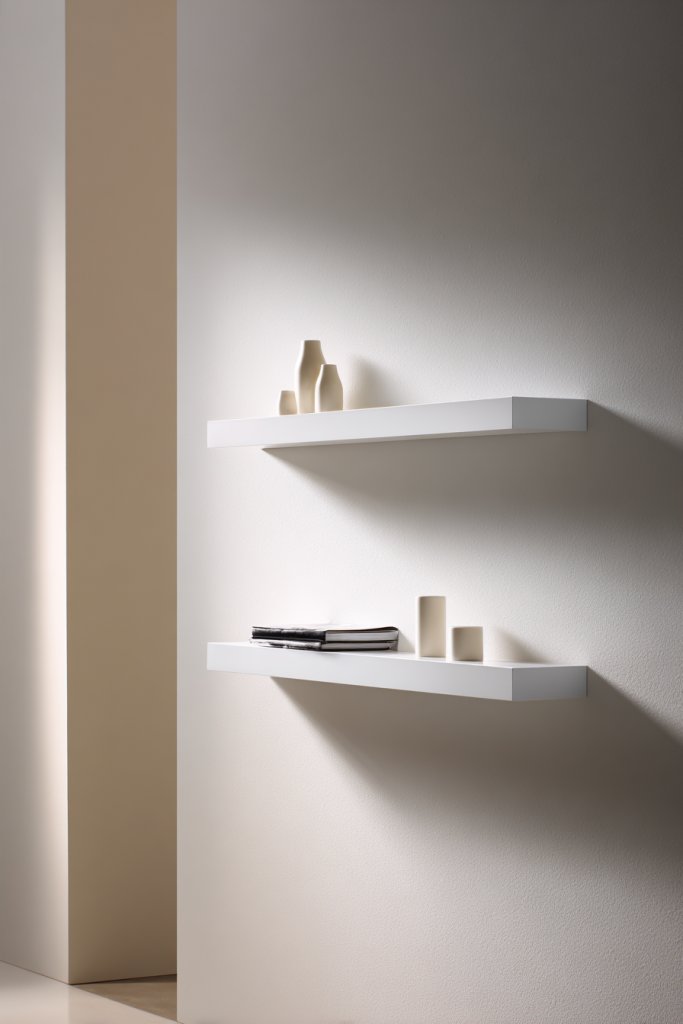
Tired of cluttered surfaces taking over your living room? Floating shelves offer a sleek solution that keeps things tidy while adding style. They’re perfect for showcasing your favorite small decorative items without sacrificing space. Less clutter means more calm, right?
Picture a set of slim, matte-finished floating shelves mounted high on a wall, holding a curated collection of colorful ceramics, candles, and tiny sculptures. They stretch across the wall, creating a visual line that guides your eye. The clean lines contrast beautifully with textured wall paint or wallpaper, adding depth. The shelves seem to float effortlessly, giving the room a modern, airy feel.
Choose shelves in different lengths and finishes—wood, metal, or acrylic—to match your decor style. In a minimalist setup, keep accessories sparse and monochromatic, while a boho space might feature vibrant, layered pieces. Seasonal swaps like small decorative bowls or themed trinkets keep the display fresh. Use vertical space in small rooms or combine with larger wall art for a layered look.
Start by measuring your wall to plan the shelf placement. Use a level and appropriate anchors for secure mounting, especially if holding heavier items. Select shelves that complement your decor—think matte black for industrial, natural wood for rustic, or glossy for modern. Arrange your items with a balance of height, color, and texture, leaving some negative space for a clean look. Keep frequently used items within reach, and reserve decorative pieces for visual impact. Regular dusting and occasional rearranging keep the display engaging.
Mix functional and decorative objects—like a small clock, a candle, or a unique figurine—to personalize the display. Incorporate unconventional items like vintage suitcases or small planters (without actual greenery, to avoid restricted content). Layer items at different depths for visual interest and avoid overcrowding. Use shelf brackets that double as design elements if you want an added touch of style.
Floating shelves are a simple upgrade that can dramatically elevate your space’s style and organization. They prove that minimalism doesn’t mean boring—it’s about curated simplicity. With just a few carefully chosen items, you can create a striking focal point that reflects your personality.
3. Compact Media Center with Hidden Storage Solutions

Cluttered electronics and tangled cords make your living room look chaotic? A compact media center with hidden storage offers a sleek way to keep everything organized. It’s about enjoying your entertainment without the mess. Who says tech and style can’t coexist?
Imagine a low-profile media console with a smooth finish, featuring concealed drawers and cabinets. Electronics are tucked away behind sliding doors or inside compartments, leaving only a minimalist surface visible. The unit’s clean lines blend seamlessly with modern decor, while hidden compartments hide away remotes, cables, and gadgets. The result: a clutter-free, streamlined look that feels calm and intentional.
Choose a unit in wood, laminate, or painted finish to match your aesthetic—Scandinavian, industrial, or contemporary. Some models include modular components for flexibility, fitting small or large rooms alike. For seasonal updates, swap out decorative accents like a textured runner or a sculptural piece on top. Incorporate cable management features for a tidy appearance. You can also add floating shelves above for additional display or storage.
Start by assessing your equipment and storage needs. Measure your space and pick a media console with enough compartments to hide cables and devices. Use cable clips and sleeves to manage cords and keep them out of sight. Assemble the unit according to instructions, anchoring it securely to avoid tipping. Arrange your electronics neatly inside, and use storage baskets or boxes within cabinets for smaller accessories. Keep daily-use devices accessible but out of view.
Personalize your media center by adding textured or patterned storage bins inside the cabinets. Incorporate decorative handles or knobs for a unique touch. Use cable covers that match your wall or furniture colors for a seamless look. Consider adding a few decorative objects on top that are simple and sleek—think sculptural ceramics or textured trays—to keep the focus on clean lines.
A well-organized media center transforms your living room into a sleek, functional space. It shows that you value both style and practicality, making your daily routines smoother. With smart hidden storage, you can enjoy tech comforts without sacrificing aesthetic appeal. It’s a small change with a big impact.
4. Statement Area Rug to Define the Living Space
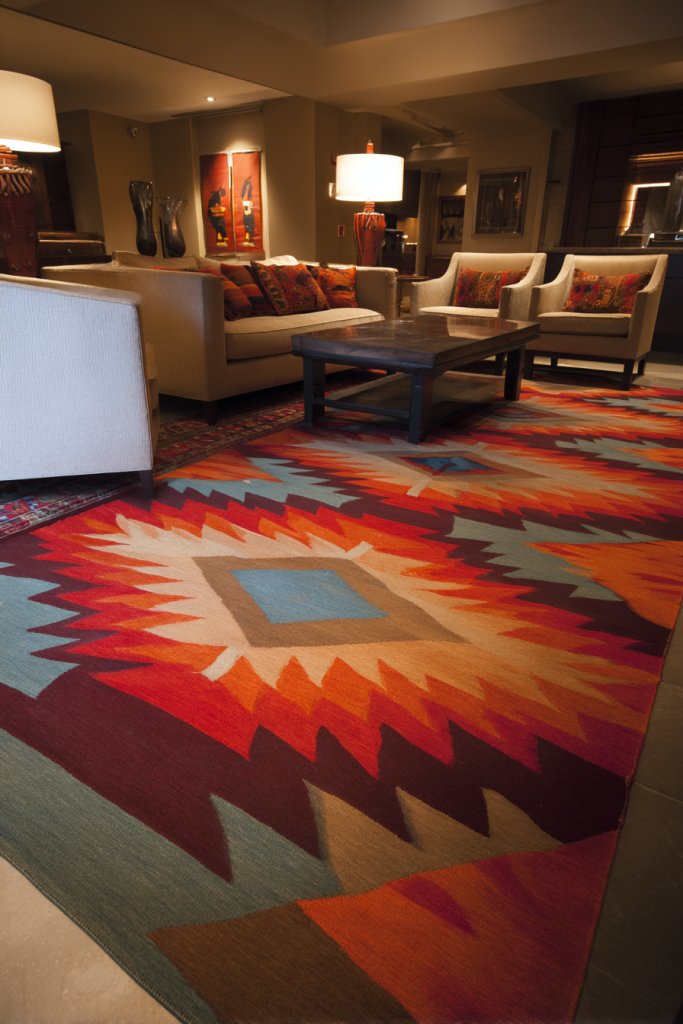
Does your living room feel a bit lost or disconnected? A bold area rug can anchor your furniture and create a clear, inviting zone. It’s like giving your space a visual handshake, making everything feel intentional. Plus, who doesn’t love a cozy underfoot sensation?
Picture a large, plush rug in a vibrant pattern or rich texture, sprawling under your sofa and chairs. It adds warmth and color, transforming a plain floor into a focal point. The tactile surface invites you to kick off your shoes and relax. The pattern complements your decor, tying together different elements for a cohesive look. It’s a visual anchor that pulls the room together.
Select a rug that suits your style—geometric for modern, floral for romantic, or neutral textured for understated elegance. Seasonal changes might mean swapping a wool rug for a lighter jute or sisal in summer. In small spaces, a smaller rug can define a cozy corner. Larger rooms benefit from expansive rugs to unify multiple seating zones. Layering rugs in different textures can add depth but keep color harmony in mind.
Measure your space carefully—aim for a rug that extends beyond furniture, ideally by at least 12 inches on each side. Choose a material that suits your lifestyle—easy-care synthetics for busy households or natural fibers for a chic, eco vibe. Lay the rug flat and smooth out wrinkles with weights or a gentle vacuum. Position your furniture so that the front legs rest on the rug, anchoring the seating area visually. Clean and rotate regularly to maintain its appearance.
Incorporate a rug with a pattern or texture that reflects your personality—think bold, geometric, or subtle and textured. Layer smaller rugs or add a fringe for extra flair. Use matching cushions or throws to tie the colors together. Consider adding decorative trims or custom embroidery for a personal touch. The right rug turns your living room into a styled sanctuary.
A statement rug elevates your decor and boosts your confidence in your design choices. It proves that a simple element can have a big visual impact. When you walk into your space, the rug’s warmth and style remind you that your home is a reflection of your taste and personality.
5. Multi-Purpose Coffee Table with Storage Compartments
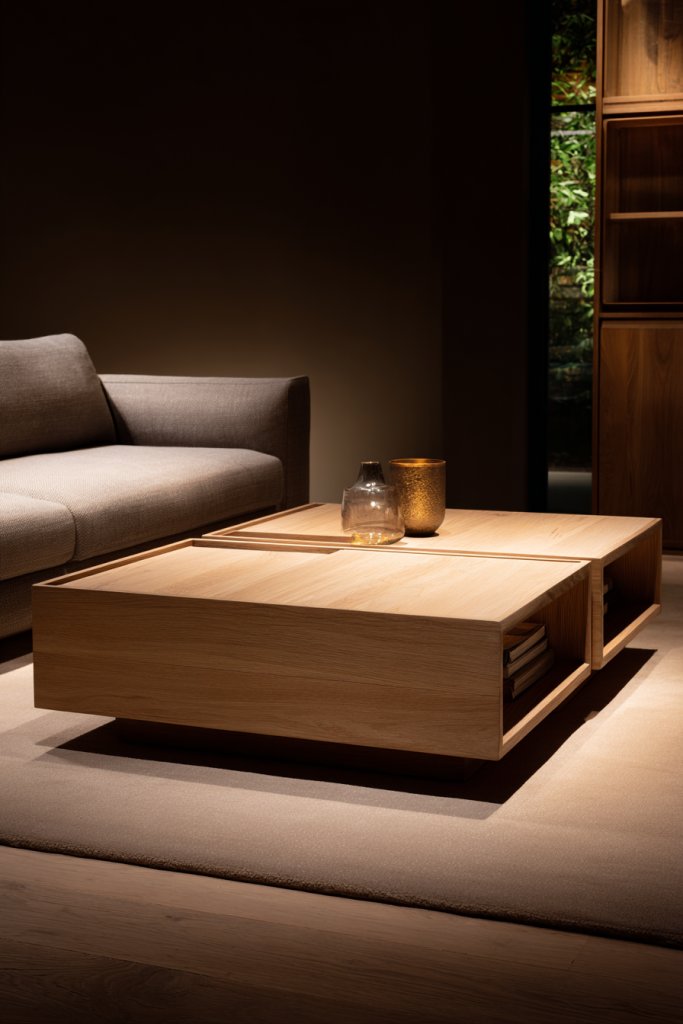
Cluttered living rooms often have a coffee table that’s more catch-all than functional. A multi-purpose table with hidden storage can keep clutter out of sight and your essentials close at hand. It’s about combining practicality with style without sacrificing one for the other. Who doesn’t want a tidy space?
Imagine a sleek coffee table with a lift-top lid or hidden drawers that store magazines, remote controls, and chargers. The surface remains clean and organized, with a smooth finish that complements your decor. When needed, the table transforms into a workspace or dining area. Its minimalist design adds a modern touch, while hidden compartments keep the room looking uncluttered.
Opt for materials that match your style—light wood for Scandinavian, dark metal for industrial, or glass for contemporary. Choose a design with multiple compartments or a lift-top for versatility. In small apartments, a compact size works best, while larger rooms can accommodate bigger, multi-level options. You can also find models with casters for easy mobility.
Measure your available space and decide what to store—think magazines, blankets, or board games. Select a table with enough internal space and a sturdy build. Assembly usually involves attaching legs or handles, so follow instructions carefully. Place it centrally to maximize access and functionality. Regularly declutter the compartments to keep the look tidy. Use decorative trays or baskets inside for better organization.
Customize your table with removable or decorative liners inside the storage compartments. Add a textured or painted surface to match your decor palette. Incorporate a few decorative objects on top—like a sculptural piece or a tray—to add visual interest. Use color-coordinated storage bins to make organization effortless. This table should be both stylish and highly functional.
A multi-purpose coffee table simplifies your living space and adds a touch of sophistication. It shows that smart design can make everyday routines smoother. When your living room looks organized and stylish, you’ll feel more relaxed and confident in your space. It’s a small upgrade with lasting impact.
6. Layered Lighting with Floor, Table, and Accent Lamps
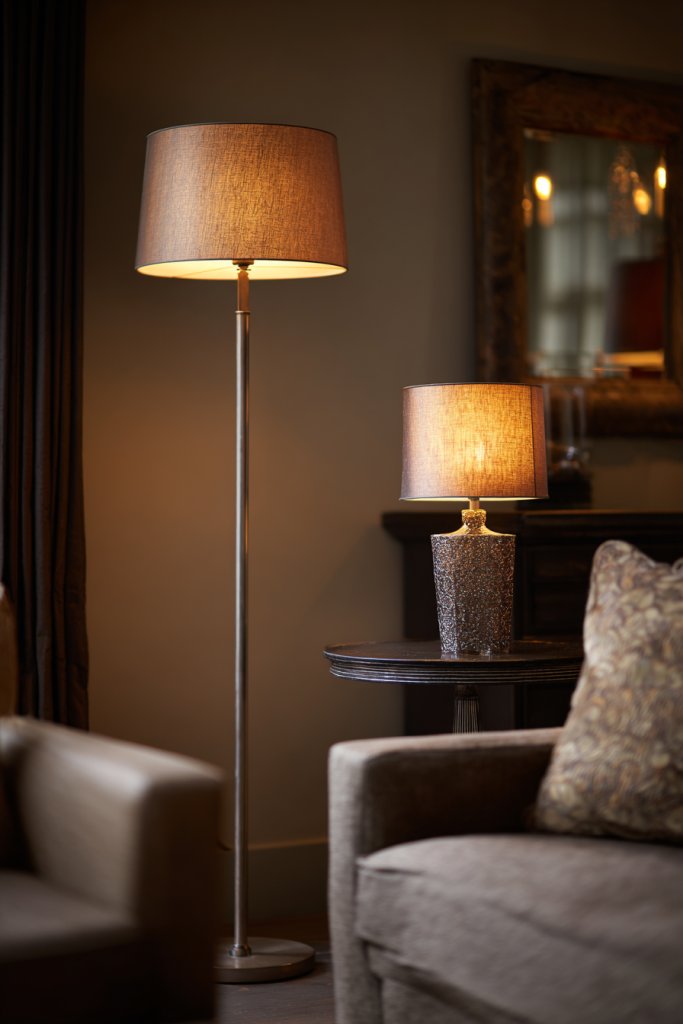
Ever notice how some rooms just feel flat or dull no matter how many decor pieces you add? Layered lighting can change that by creating depth and ambiance. It’s about combining different light sources for a warm, inviting glow that’s adaptable. Who doesn’t want a cozy, well-lit space?
Picture a room illuminated by a tall floor lamp casting a soft glow, complemented by a table lamp on a side table creating pools of warm light. Small accent lights or sconces add highlights to architectural features or decorative elements. The layered effect creates a dynamic atmosphere where you can relax, read, or entertain. The varying intensities and directions paint a picture of comfort and versatility.
Mix and match lighting styles—sleek floor lamps, minimalist table lamps, or bold statement fixtures—depending on your decor theme. Use dimmers to control brightness and set different moods. For seasonal ambiance, incorporate warm-colored bulbs or candle-like LEDs. In small spaces, wall-mounted sconces save space while providing layered illumination. Adjust placement based on furniture arrangement for maximum effect.
Start with a lighting plan that considers function and mood. Place a main source like a floor lamp in a corner for overall illumination. Add table lamps on side tables or consoles for task lighting. Use accent lighting to highlight artwork or architectural details, avoiding overhead pendant lights unless necessary. Choose bulbs with warm color temperatures—around 2700K for cozy vibes. Use smart plugs or dimmers for easy control. Regularly check and replace bulbs to maintain ambiance.
Layer your lighting with decorative fixtures—think sculptural lamps or vintage-inspired designs. Incorporate smart lighting options for customizable scenes and remote control. Use textured lamp shades or fabric covers to soften the light and add visual interest. Consider adding LED strips behind furniture or along shelves for subtle backlighting. These touches make your space adaptable and uniquely yours.
Layered lighting transforms a mundane room into a cozy retreat. It enhances mood, functionality, and style effortlessly. When you master this, every time you enter your living space, you’re greeted with a warm, inviting glow that lifts your spirits and encourages relaxation.
7. Vertical Wall-Mounted Storage for Books and Decor
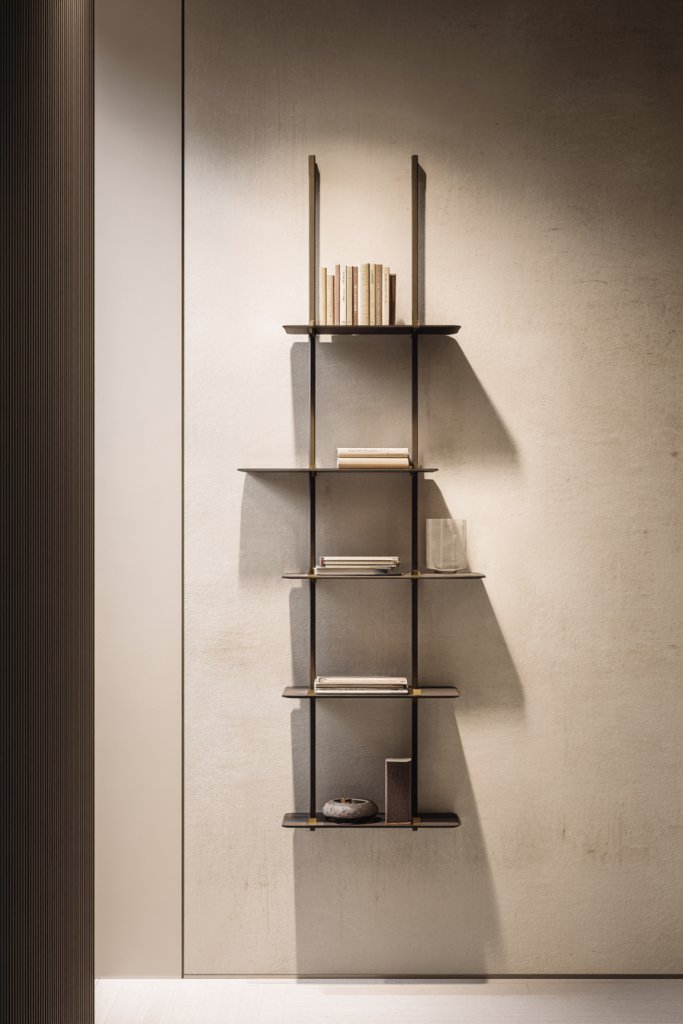
Cluttered floors and surfaces can make even the most stylish living room feel cramped. Vertical wall-mounted storage offers a clever way to free up space while adding visual interest. It’s about making every inch work smarter, not harder. Want a tidier, more open vibe?
Imagine slim, sleek wall-mounted units with open cubbies or closed cabinets, arranged asymmetrically for a modern look. These units hold books, small decorative objects, or even functional items like chargers or remote controls. The open design keeps essentials accessible while maintaining a clean, minimalist aesthetic. The wall becomes a focal point, balancing practicality and style.
Select wall units in materials that match your decor—light wood, matte black, or glossy lacquer. Mix open and closed storage for variety, keeping frequently used items within easy reach. For an eclectic look, incorporate decorative baskets or boxes inside open shelves. Use vertical space in small apartments or to add visual height in larger rooms. Consider floating shelves or modular wall panels for flexibility.
Start by choosing a wall that’s underused or visually prominent. Use a level and appropriate anchors to mount your units securely. Arrange items by size and frequency of use, keeping everyday essentials at eye level. Use simple storage solutions like baskets or small boxes inside open compartments for better organization. Regularly dust and swap out items to keep the display fresh. For added visual appeal, align units to create a continuous, flowing wall feature.
Add decorative elements like textured boxes, themed baskets, or colorful containers to personalize your storage. Incorporate lighting—like LED strips or puck lights—inside or below units to enhance visibility and style. Mix in personal collectibles, vintage finds, or heirlooms that tell your story. Keep the look balanced and clutter-free for maximum impact.
Vertical storage is a smart, stylish way to maximize space and showcase your personality. It transforms blank walls into functional art, making your living room feel curated and intentional. Mastering this can bring a new level of confidence in your interior styling skills, turning a small space into a statement of clever design.
8. Functional, Space-Saving Fold-Out or Extendable Furniture
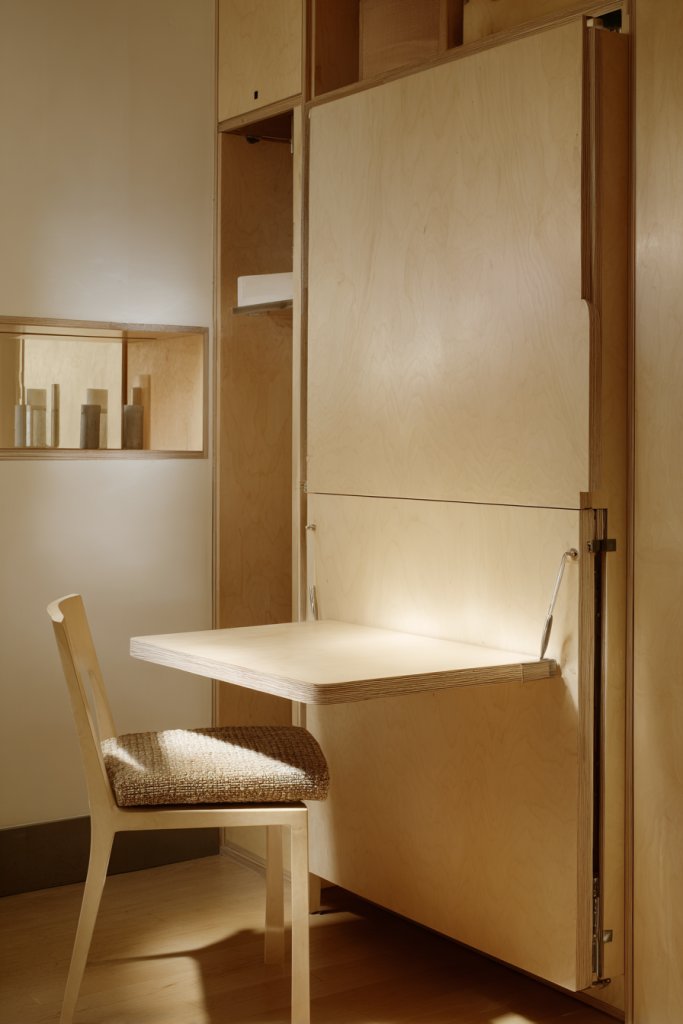
Limited space makes it tough to host guests or accommodate sudden needs. Fold-out or extendable furniture solves this by offering flexibility without sacrificing style. It’s about transforming your living room into a versatile space at a moment’s notice. Who wouldn’t want that kind of adaptability?
Picture a sleek sofa that folds out into a bed or a dining table that extends to seat more guests. These pieces often feature clean lines and compact designs, blending seamlessly with modern decor. When not in use, they look like stylish furniture, but when needed, they open up to serve multiple functions. The clever mechanisms are hidden, maintaining a sleek aesthetic.
Choose from different styles—minimalist, industrial, or classic—based on your taste. Materials vary from wood to metal, with options for upholstery that match your room’s color scheme. For seasonal use, opt for lightweight, portable tables or foldable chairs that can be stored away easily. In small apartments, these pieces create the illusion of more space, while larger rooms benefit from multi-use configurations.
Assess your space and identify where a fold-out or extendable piece could make the biggest impact. Select models with sturdy mechanisms and quality finishes. For sofas, test the fold-out feature to ensure smooth operation and comfort. For tables, measure extension options to accommodate your typical guest count. Set up in a way that allows easy access and movement around the furniture. Regular maintenance and checks ensure durability over time.
Add custom cushions or slipcovers to match your decor, and incorporate protective pads on extendable parts. Use decorative tablecloths or placemats when extended for special occasions. Incorporate a matching set of foldable or stackable chairs for a cohesive look. Personalize with small decorative touches—like a textured table runner or a statement centerpiece—that enhance functionality.
Flexible furniture proves that small spaces can be both stylish and functional. It encourages creative room layouts and makes hosting a breeze. When you see how easily your furniture adapts, your confidence in interior solutions skyrockets, inspiring you to optimize every inch of your home.
9. Use of Neutral Tones with Pops of Color via Accessories
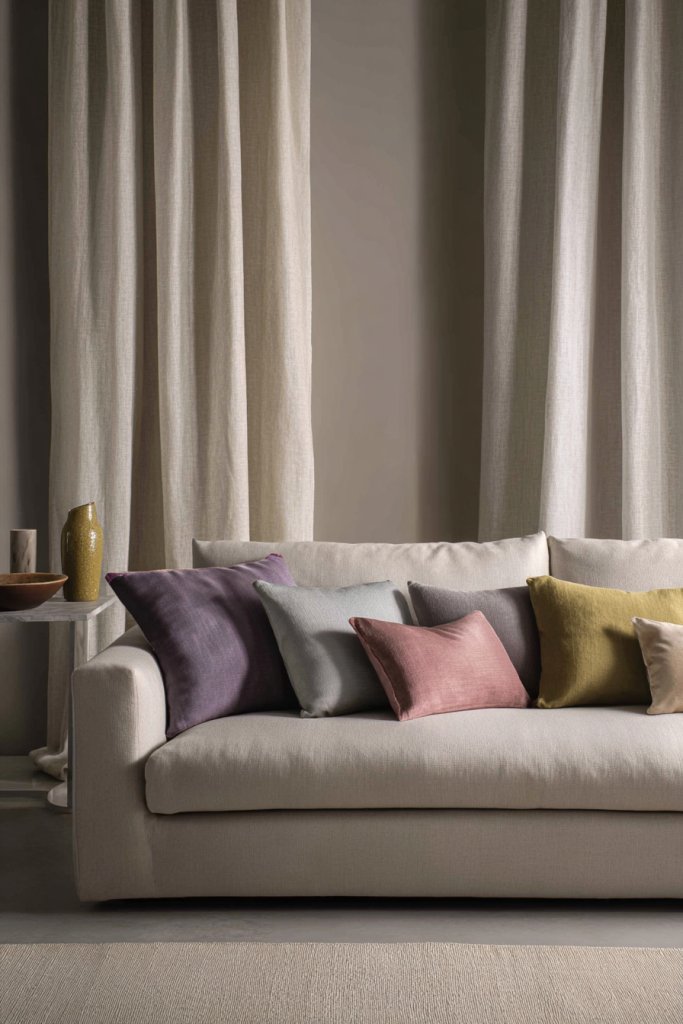
Struggling to create a cohesive look in your living room? Neutral tones provide a calm, versatile backdrop that can be easily refreshed with pops of color. It’s a foolproof way to keep things stylish and flexible. Who doesn’t want a space that’s both soothing and lively?
Visualize soft beige walls paired with cream-colored furniture, accented by cushions, throws, or decorative details in bold hues like turquoise or mustard. The neutral base acts as a canvas, allowing vibrant accessories to stand out without clashing. Textured fabrics and subtle patterns add depth, making the space feel layered and inviting. The contrast creates a balanced, harmonious look that feels fresh and modern.
Adjust the intensity of your pops of color—try pastel shades for a soft vibe or vivid hues for a lively atmosphere. Change accessories seasonally or as trends evolve, swapping out cushions, throws, or small decor items. In minimalist decor, keep color accents minimal—just one or two bold pieces—while maximalist styles can incorporate multiple colorful elements. Use textured textiles or decorative trims to add visual interest without overwhelming the space.
Start with a neutral palette for walls and larger furniture. Choose accent cushions and throws in bright colors or bold patterns, ensuring they complement each other. Use a color wheel to select contrasting or harmonious shades. Incorporate textured fabrics like boucle, velvet, or woven textiles to add depth. Balance the accessories across the room for visual flow. Regularly refresh your accents to keep the look vibrant and current.
Create your own color story by mixing shades and textures—think a soft cream sofa with a mustard throw and teal cushions. Incorporate decorative trims or embroidered details for added personality. Use decorative trays or bowls in matching tones to unify the look. Keep your color palette flexible so you can easily update accessories without major redecorating.
Using neutral tones with colorful accents offers endless styling options and flexibility. It allows your personality to shine through small details while maintaining a serene overall vibe. Once you master this balance, your confidence in curating stylish, adaptable spaces will grow exponentially.
10. Incorporation of Textured Fabrics for Visual Interest

Flat, smooth surfaces can make a living room look dull or uninspired. Textured fabrics add tactile richness and visual depth, elevating your decor instantly. It’s about creating a space that invites touch and feels layered. Don’t settle for boring—bring on the texture!
Imagine a plush velvet cushion paired with a chunky woven throw and a boucle armchair. The mix of textures catches the light differently, creating shadows and highlights that add dimension. Textured fabrics in curtains, upholstery, or cushions bring warmth and coziness, making the space feel more inviting. The tactile variation invites you to touch, sit, and relax, turning your living room into a sensory experience.
Mix textures thoughtfully—pair smooth leather with rougher woven or boucle fabrics for contrast. For a cozy winter vibe, layer plush throws and velvet cushions; for summer, switch to lighter, textured linens. Incorporate tactile wall coverings or textured rugs as accents. Use textured fabrics in small doses if your space is busy, or go bold with wall-to-wall upholstery for a statement look. Seasonal updates keep the tactile energy fresh.
Choose fabrics based on usage—durable textiles for high-traffic areas, softer options for seating and throws. Mix and match textures within a cohesive color palette to avoid chaos. When selecting upholstery, consider options like boucle, velvet, or woven materials for durability and style. Use layered textiles to create an inviting atmosphere, with cushions, throws, and curtains adding tactile interest. Regular cleaning and maintenance preserve their look and feel.
Add textured cushions or throws in your favorite colors for personality. Incorporate tactile wall hangings or fabric art to add visual interest without clutter. Use textured curtains or drapes to soften natural light and enhance the room’s depth. Experiment with different textures in small accessories before committing to large pieces. This approach creates a dynamic, engaging environment that’s full of sensory surprises.
Textured fabrics elevate your living room from flat to fabulous with minimal effort. They prove that tactile richness is a key element of good design. When you embrace textures, you create a space that’s not just seen but felt, making your home more inviting and stylish.
11. Innovative Use of Corner Spaces with Corner Sofas or Shelves
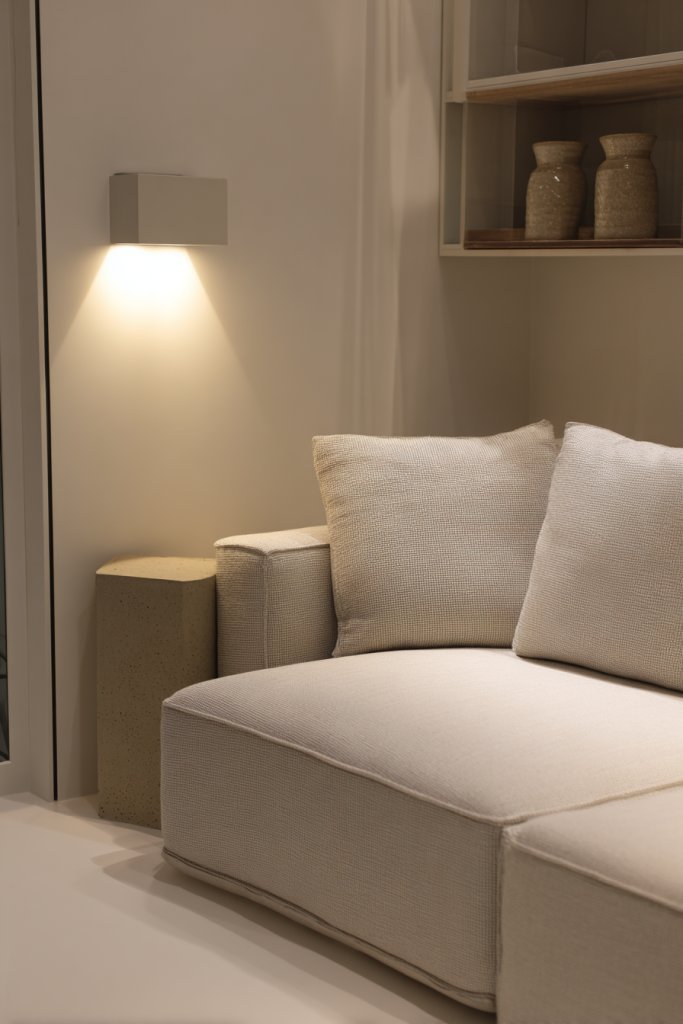
Corners are often underused or awkwardly filled, wasting valuable space. Innovative solutions like corner sofas or shelves turn these areas into functional focal points. It’s about making every inch of your apartment work harder and smarter. Who wouldn’t want to maximize their space?
Envision a sleek corner sofa snugly fitting into a room’s nook, creating a cozy seating zone. Alternatively, corner shelves in geometric or floating styles hold books, decor, or storage baskets without blocking pathways. These solutions add architectural interest, emphasizing the room’s shape. The corner becomes a deliberate design feature rather than an afterthought, adding depth and functionality.
Choose corner furniture that suits your style—plush sectional sofas for comfort or angular designs for modern minimalism. Corner shelves can be open or closed, in wood, metal, or composite materials. Use decorative accents like baskets, folded textiles, or small storage boxes to keep the space organized. Adapt these ideas for small or large rooms by scaling the furniture and shelving accordingly.
Measure corner dimensions carefully before purchasing furniture or shelves. For corner sofas, ensure enough depth and width for comfortable seating. Mount corner shelves securely, using appropriate anchors for your wall type. Arrange items in a way that balances function and visual appeal—think mixing books with decorative objects. Use the space to showcase your personality while maintaining practicality. Regularly declutter and rotate accessories for freshness.
Personalize corner shelves with unique objects—vintage collectibles, travel souvenirs, or curated small decor pieces. Use textured or patterned storage baskets to add visual interest. For corner sofas, add cushions or throws that complement your overall decor. Incorporate lighting—like wall-mounted sconces or LED strips—to highlight these features. These touches turn corners into statement zones.
Using corners creatively shows your knack for maximizing small spaces. It’s a clever way to add comfort and style without crowding the room. Mastering this technique boosts your confidence in designing functional, beautiful interiors—making every inch count.
12. Personal Touches with Unique Decorative Trays and Bowls
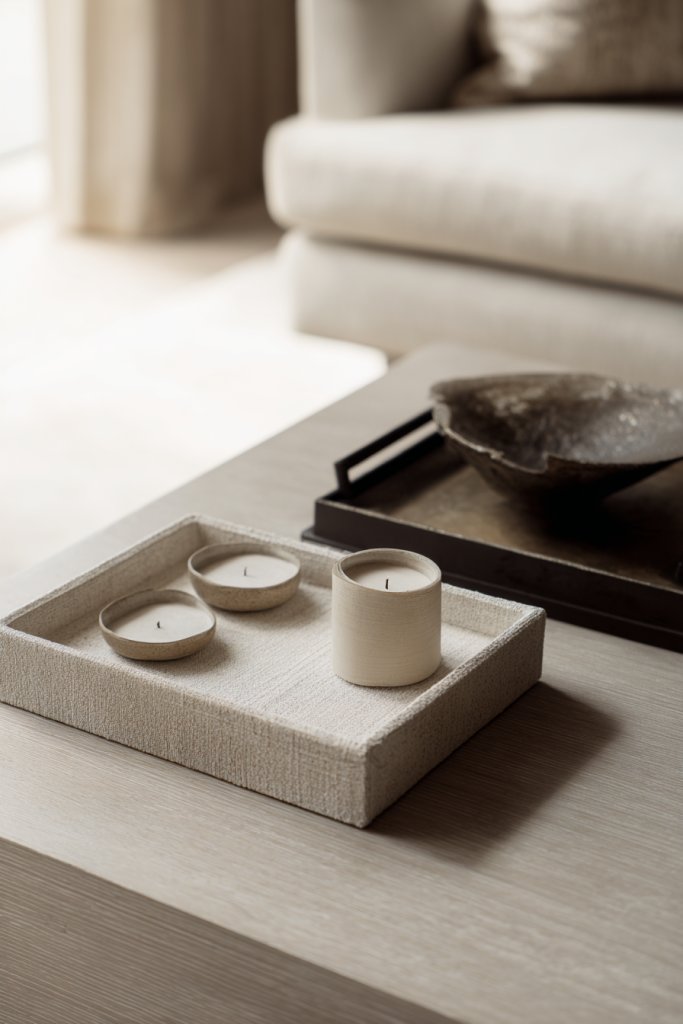
Generic surfaces and cluttered tables can make your living room feel impersonal or chaotic. Unique decorative trays and bowls offer a simple way to add personality and organization. They’re small details that make a big difference in creating a curated, stylish space. Want to elevate your decor effortlessly?
Think of a carved wooden tray with intricate details, holding a few carefully chosen objects—candles, a small sculpture, or a collection of decorative stones. Or a sleek ceramic bowl filled with textured or metallic accents that catch the light. Placed on a coffee table or sideboard, these pieces serve as focal points that tie your decor together. They add layers of interest and help organize everyday items.
Choose trays and bowls in different materials—metal, wood, ceramic, or acrylic—to match your style. Use them seasonally—filled with pinecones or ornaments during holidays, or shells and stones in summer. Incorporate personal items like vintage jewelry, keys, or souvenirs for a personal touch. Different shapes—round, rectangular, or abstract—add visual variety. Keep the arrangement minimal or layered for a curated look.
Select a tray or bowl that fits your space and style. Place it on a coffee table, side table, or shelf as a base for decor. Fill it with a mix of textured objects—think metallic accents, candles, or natural elements—without overcrowding. Use small risers or stacks to create height variation. Regularly update the contents to match seasons or moods. This small detail can transform the look and feel of your living space.
Personalize trays with engraved or painted designs, or choose handcrafted items to add character. Combine different materials—metal with wood, or ceramic with textiles—to create contrast. Use decorative trays to hold everyday essentials like remotes or keys, keeping surfaces tidy. Incorporate meaningful objects—family heirlooms or travel souvenirs—to infuse personality into your decor.
A well-chosen tray or bowl can serve as a signature decor piece. It’s a simple, inexpensive way to show off your style and keep things organized. Once you see how a few personal touches elevate your space, your confidence in styling will grow. Small details like these make your home uniquely yours.
13. Accent Walls with Peel-and-Stick Wallpaper or Paint
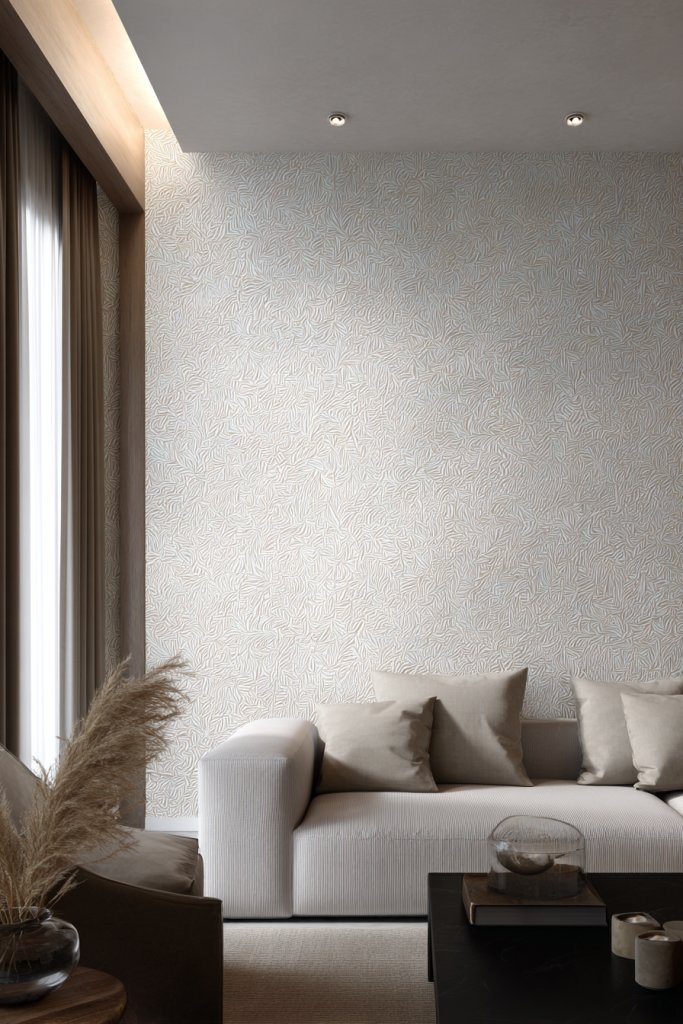
Feeling like your living room lacks a focal point? An accent wall can instantly add drama and personality without a full redecoration. It’s a cost-effective way to create a statement that sets the tone for your entire space. Ready for a bold change?
Picture a wall painted in a rich jewel tone or covered with peel-and-stick wallpaper featuring geometric or botanical patterns. It creates a striking backdrop for your furniture and decor. The textured, patterned surface draws the eye and adds depth, making the room feel layered and curated. The contrast with neutral walls or furniture enhances the visual impact.
Choose bold colors or patterns that reflect your personality—think deep blues, earthy greens, or metallic accents. Use removable wallpaper for easy updates or temporary decor experiments. For a subtle effect, select a slightly darker hue than the surrounding walls. Apply in small sections for a more modern, patchwork look, or cover an entire wall for maximum impact. Coordinate your decor to complement the accent wall for a harmonious look.
Prepare the wall surface by cleaning and smoothing it. For paint, choose a high-quality primer and finish in your preferred shade. For peel-and-stick wallpaper, measure carefully, cut to size, and apply from top to bottom, smoothing out air bubbles. Use painter’s tape to create clean edges if painting. Add a protective sealant or matte finish for durability. Keep tools and supplies handy for quick fixes and adjustments.
Incorporate textured or metallic paints for extra flair. Use wall decals or stencils to add custom designs on top of the accent wall. Pair with accessories in matching or contrasting colors to enhance the effect. Change up the look seasonally with removable wallpaper or paint accents. This small detail boosts your confidence in DIY decor and makes your space truly yours.
Accent walls demonstrate that bold design is within reach and can dramatically transform a room. They give you a chance to experiment with color and pattern without overhauling your entire decor. When you see how a single wall changes the vibe, your confidence in your styling skills will grow. It’s a simple step toward a more personalized and stylish home.
14. Multi-Functional Room Dividers for Open Layouts
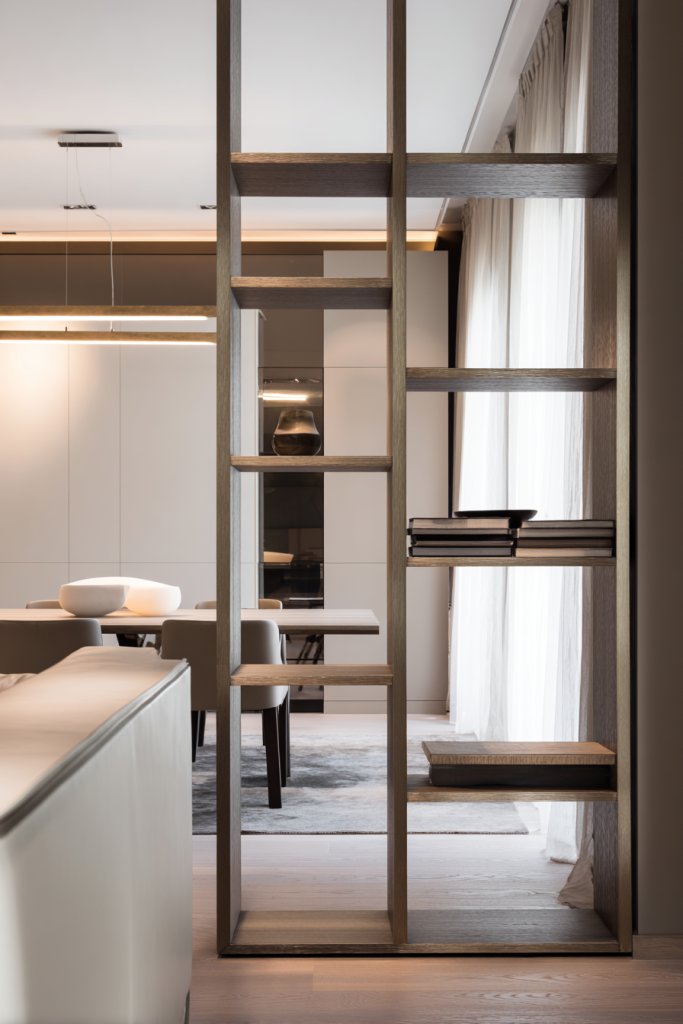
Open floor plans are great for spaciousness but can sometimes lack privacy or definition. Multi-functional room dividers help carve out zones without sacrificing openness. They’re perfect for creating separate seating, work, or relaxation areas. Want a flexible layout that adapts to your needs?
Imagine using a stylish bookshelf or folding screen to separate your living area from a work nook. The divider’s design adds visual interest while acting as a backdrop for decor. It creates a sense of intimacy and order, even in a large, open space. You can see how it defines zones without creating walls, maintaining a light and airy atmosphere.
Choose from materials like wood, fabric, or metal based on your decor style. In a minimalist space, opt for sleek, simple screens; in boho or eclectic rooms, layered textiles or decorative panels work well. Incorporate storage or display elements into the divider to maximize utility. Use lightweight or foldable options for easy rearrangement or storage when not in use. Adjust height and opacity to control privacy levels.
Select a divider that suits your room’s dimensions and style. Securely position it to create a natural boundary, ensuring stability. For bookshelves, assemble according to manufacturer instructions and fill with books or decor for a personalized look. For fabric screens, attach to a sturdy frame or track system. Be mindful of traffic flow and natural light to keep the space functional. Regularly update the divider’s contents to keep the zone fresh.
Customize your divider with decorative fabrics, paint, or art panels. Incorporate storage baskets or small shelves into the design for added utility. Use lighting—like string lights or LED strips—around or behind the divider for ambiance. Add personal touches such as photos, textiles, or collectibles to make the space inviting. The divider becomes a statement piece that reflects your style.
Room dividers show that open spaces can be both functional and stylish. They help you create zones that suit your lifestyle while maintaining a sense of flow. Mastering this concept boosts your confidence in designing flexible, personalized interiors. It’s a simple yet powerful way to make your home work better for you.
15. Layered Window Treatments for Style and Light Control
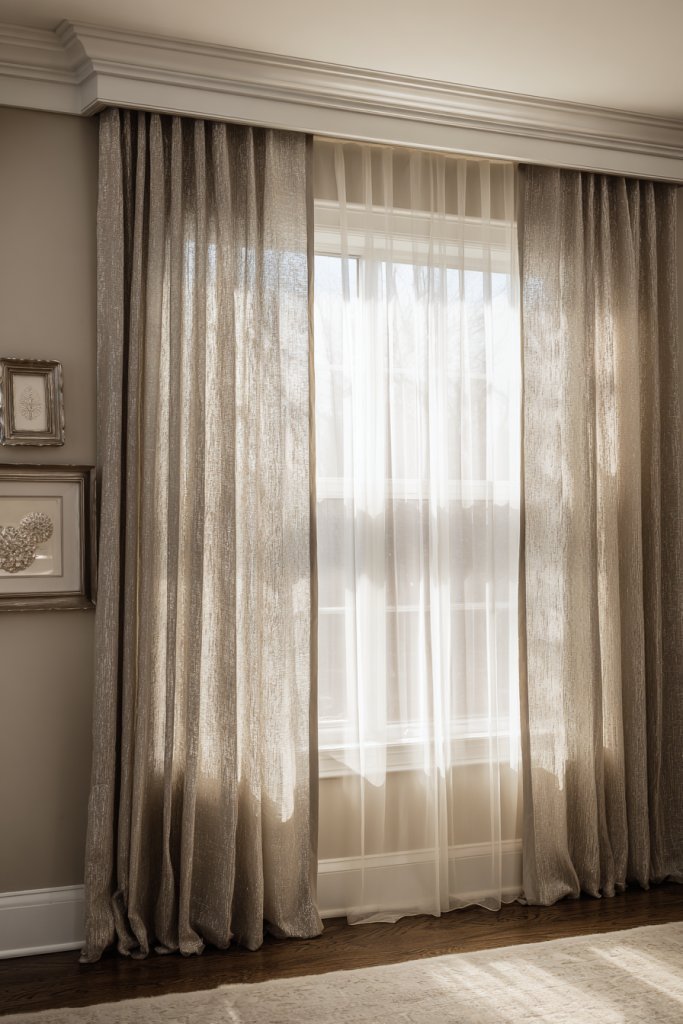
Struggling with harsh sunlight or lack of privacy? Layered window treatments offer control and style all in one. Combining sheer curtains with blackout or decorative drapes lets you customize lighting and mood effortlessly. Want your living room to feel cozy yet bright?
Visualize sheer curtains filtering soft daylight, paired with heavier, textured drapes in a complementary color. When closed, they block out light and add a sense of enclosure; when open, they let in natural rays. The layers add depth and texture to your windows, turning them into a design feature. The fabric choices, patterns, and colors work together to create a harmonious look.
Mix different fabrics—linen, velvet, silk—for visual richness. For a minimalist style, keep the layers monochrome and simple; for boho, incorporate patterned or fringed textiles. Use tiebacks or decorative rods to switch between styles quickly. Consider blackout liners for functionality, or sheer overlays for a light, airy feel. Adjust layering according to season or mood.
Measure your windows carefully, accounting for curtain rod placement and desired length. Install sturdy rods that can support layered fabrics, using anchors for heavy drapes. Hang sheer curtains first, then add heavier drapes or decorative panels as desired. Use tiebacks or hooks to open and close layers easily. Regularly clean fabrics and adjust layers to suit the time of day or occasion. This approach enhances both privacy and aesthetics.
Choose fabrics in textures and colors that reflect your personality—think metallic accents, embroidered details, or textured weaves. Incorporate decorative tiebacks or curtain rings that serve as accents. Layer different patterns or solids for a personalized look. Add a touch of luxury with textured or fringed trims. These details elevate your window dressing into a design statement.
Layered window treatments give your living room a polished, sophisticated vibe. They empower you to control natural light and privacy with ease, enhancing your confidence in styling. When your space feels just right—bright but cozy—you’ll appreciate the effort, inspiring more creative upgrades.
16. Incorporating Small-Scale Indoor Plants in Trendy Containers
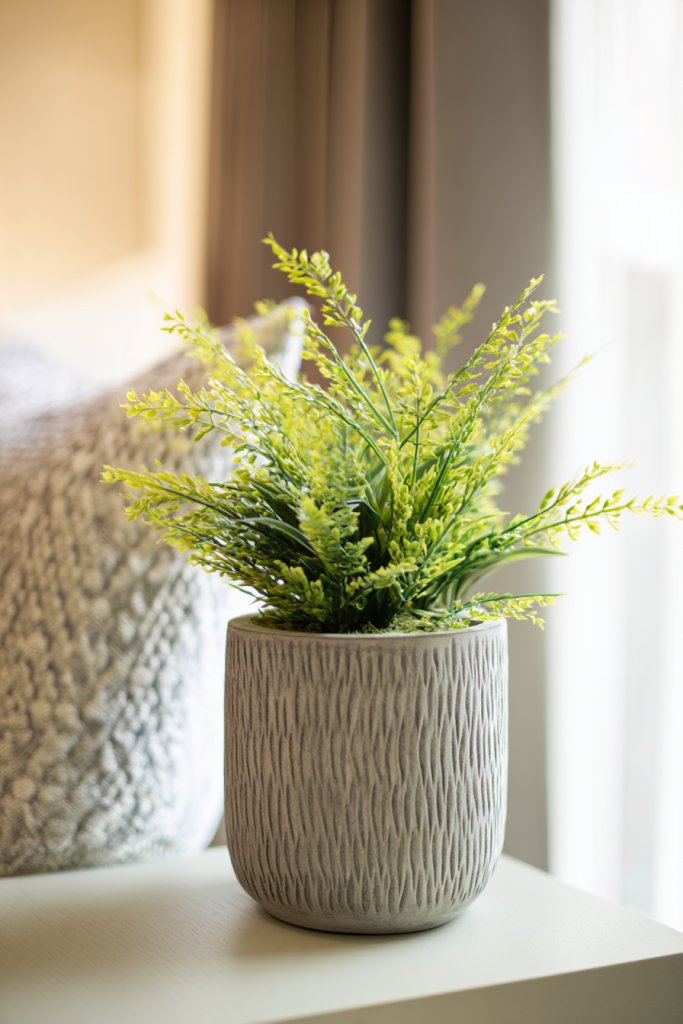
Feeling like your space is missing a touch of nature? Small indoor plants in stylish containers add life and freshness without overwhelming your apartment. They’re perfect for those who want a bit of greenery but lack space or a green thumb. Ready to breathe new life into your decor?
Picture tiny succulents in geometric ceramic pots or mini ferns in textured terracotta containers. Place them on floating shelves, side tables, or windowsills to add pops of green. The combination of plant and container styles creates a curated, modern vibe. The visual contrast of lush greenery against neutral or textured backgrounds makes the space feel vibrant and alive.
Mix and match containers—metal, ceramic, woven—to suit your decor. Use plant stands or small terrariums for added height and visual interest. Change the plant selection seasonally or based on lighting conditions—succulents for bright spots, small ferns or pothos for shaded areas. Keep the containers in neutral tones for a minimalist look or bold colors for fun accents. Group plants in clusters for a striking display.
Choose small, low-maintenance plants suited for your environment—succulents, air plants, or small herbs. Select containers that drain well and match your decor style. Place plants in the chosen containers, ensuring proper soil and watering requirements. Position them where they get the right amount of light—near windows or under grow lights. Water sparingly, and regularly check for signs of over- or under-watering. Rotate or rearrange them for variety.
Decorate containers with textured paints, decals, or handmade wraps for a personal touch. Incorporate decorative stones or sand in the containers for added flair. Use plant labels or small figurines to create themed arrangements. Mix plants with different textures and colors for variety. These tiny touches turn simple greenery into a styled feature.
Small indoor plants show that even minimal effort can boost your space’s vibe. They enhance your confidence in styling and caring for your home. With a few well-chosen containers, you create a lively, fresh environment that’s both beautiful and soothing. It’s your daily dose of nature, right at home.
17. Creative Use of Mirrors to Enhance Space and Brightness

Rooms that feel small or dark can drain your energy. Mirrors are a game-changer, making spaces look bigger and brighter instantly. They reflect light and add depth, creating a more open, airy vibe. Want a simple trick that works every time?
Imagine a large, ornate mirror hung across from a window, bouncing sunlight throughout the room. Or a cluster of smaller, decorative mirrors arranged in a geometric pattern on a feature wall. The reflection doubles the visual space and enhances natural light, making everything feel more expansive. The frames add a decorative element that complements your decor style. The effect is both functional and artistic.
Choose mirrors with frames that match your aesthetic—sleek metal for modern, distressed wood for rustic, or ornate for vintage. Use full-length mirrors to make rooms feel taller or place decorative mirrors above furniture for focal points. Consider mirror tiles or panels for a bold, contemporary look. Position mirrors to reflect natural light or focal points, optimizing their effect.
Select a wall or space that benefits from visual expansion—entryways, behind sofas, or opposite windows. Mount securely using appropriate anchors, ensuring safety. For a cohesive look, coordinate your mirror frames with other decor elements. Experiment with placement to maximize light reflection and room perception. Clean regularly to maintain clarity and brightness. Combine with lighting for added glow.
Decorate frames with paint, decals, or textured finishes for a personalized touch. Incorporate decorative elements like LED backlights or string lights behind the mirror for ambiance. Use mirrors with unique shapes—hexagons, circles, or abstract forms—to add visual interest. Group multiple mirrors for a gallery effect or a statement wall that showcases your style.
Mirrors are a simple yet powerful way to elevate your decor. They boost your confidence in space planning and styling, proving that a small change can transform a room. When your space feels larger and brighter, your mood and confidence naturally improve, making your home a true sanctuary.
18. Artistic Wall Hangings with Textured or Tactile Elements
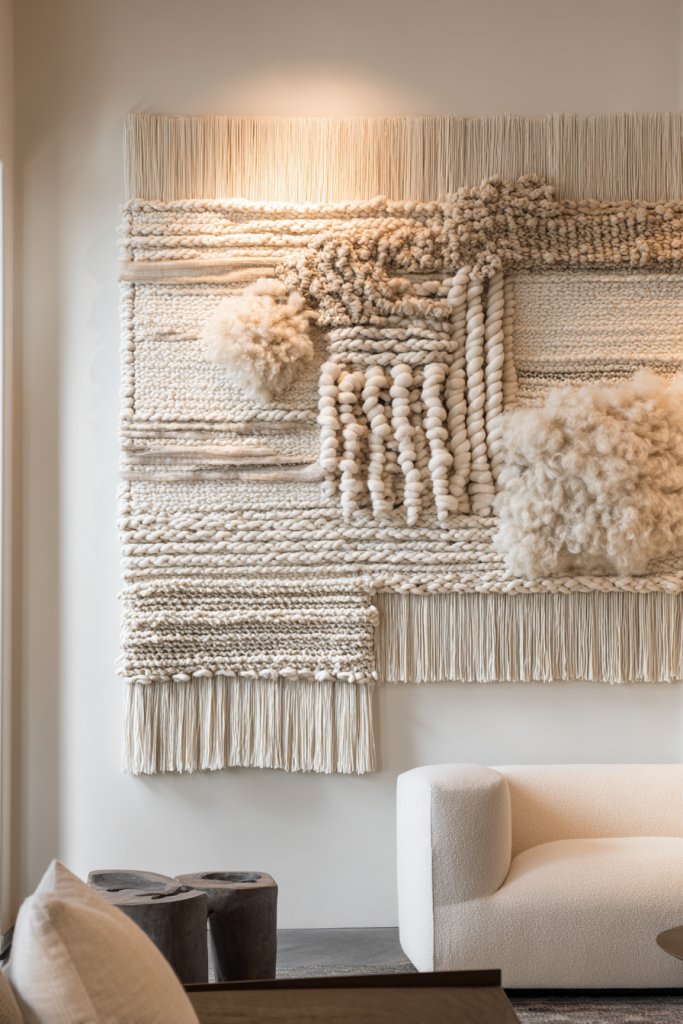
Plain walls can make your living room look bland or uninspired. Artistic wall hangings with textured or tactile elements add personality and depth without clutter. They’re a subtle way to turn blank spaces into focal points that tell your story. Ready to add some artistic flair?
Picture woven wall hangings with fringes, textured tapestries with embossed patterns, or fabric art with layered materials. These pieces create a sense of movement and dimension, catching light and shadows in interesting ways. They add warmth and personality, making the room feel curated and layered. The tactile quality invites touch and exploration, making your space multi-sensory.
Mix different textures—knitted, woven, embroidered—for visual variety. Use fabric art in neutral tones for a calming effect or bold textiles for a statement. Layer multiple pieces for a gallery wall with depth and interest. Incorporate materials like jute, linen, or textured wool to match your decor theme. Change pieces seasonally or for different moods to keep the vibe fresh.
Select wall hangings that suit your space and style—large tapestries for a statement or smaller woven pieces for accents. Mount securely using appropriate hooks or rods, ensuring safety. Arrange pieces asymmetrically or in a grid for visual rhythm. Consider incorporating frames or backings for a polished look. Regularly clean or rotate the art to maintain vibrancy and relevance.
Create your own wall hangings using textiles, fibers, or mixed media for a DIY touch. Add embellishments like beads, shells, or embroidery for extra texture. Coordinate with cushions or throws to unify the theme. Incorporate meaningful symbols or colors that reflect your personality. These textured pieces become a signature element in your decor.
Tactile wall art shows your creative side and enhances your confidence in personal styling. They prove that decor doesn’t have to be traditional or flat—texture is key. When you master layering textures, your entire space gains a richer, more inviting character. It’s a simple way to make your home stand out and feel uniquely yours.
19. Use of Modular Furniture for Customizable Layouts
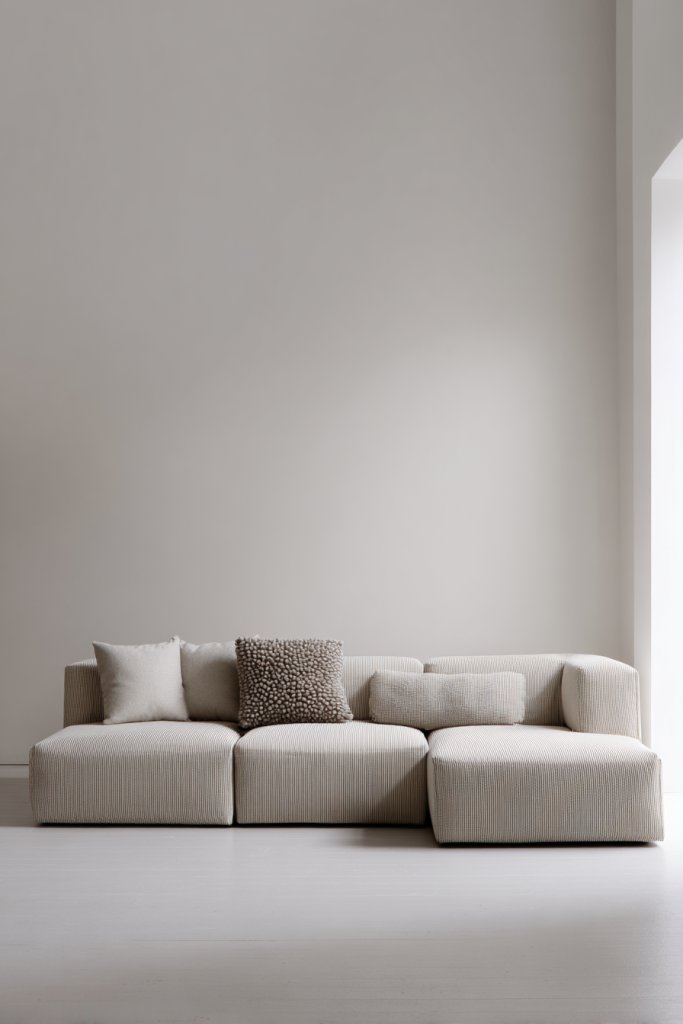
Fixed furniture can feel limiting, especially in small apartments with changing needs. Modular furniture offers flexibility, letting you customize layouts for lounging, working, or entertaining. It’s about adapting your space to fit your life, not the other way around. Want effortless versatility?
Picture a sectional sofa composed of individual pieces that can be rearranged into a U-shape or separated into separate seats. Or a modular shelving unit that can expand vertically or horizontally as needed. These pieces blend seamlessly with your decor, creating a tailored look. The ability to reconfigure makes the space feel fresh and functional, perfect for hosting or cozy nights.
Choose neutral, sleek designs that can work with various styles—contemporary, industrial, or eclectic. Mix and match different modules—storage, seating, tables—for ultimate flexibility. In small spaces, create zones or hide away clutter with modular units that double as storage. For larger rooms, combine multiple pieces for a cohesive layout. Seasonal rearrangements keep the environment dynamic.
Assess your space and decide on the functions you need—seating, storage, work surfaces. Select modular pieces that are easy to assemble and disassemble, with sturdy connectors. Arrange them to optimize traffic flow and functionality. Use protective pads or rugs underneath to prevent slipping. Regularly review your layout and adjust modules to suit your current needs. Maintenance involves tightening connectors and cleaning surfaces.
Personalize modules with cushions, throws, or decorative panels that match your decor. Add built-in features like hidden drawers or fold-out tables for extra utility. Use different finishes—wood, metal, or painted surfaces—to match your style. Incorporate your favorite colors or textures to make the units feel integrated and cohesive. These adaptable pieces reflect your evolving taste.
Modular furniture shows that you can design with flexibility and style in mind. It boosts your confidence in creating a home that adapts to your lifestyle. As you experiment with different configurations, you’ll discover how versatile and stylish small spaces can be. It’s a smart investment in both form and function.
20. Incorporation of Metallic Accents for a Touch of Glam
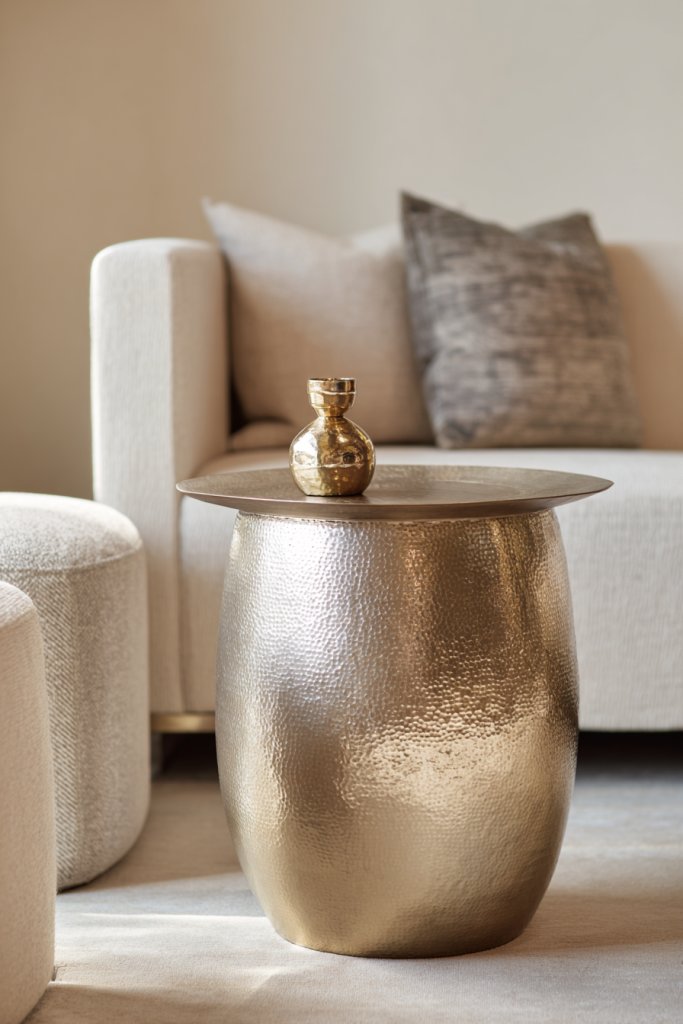
Want to elevate your living room’s style without a full overhaul? Metallic accents add a touch of glamour and sophistication that instantly upgrades any decor. They reflect light and add visual interest, making your space look more polished. Who doesn’t love a little luxe?
Imagine a brass-framed mirror, gold lamp bases, or silver side tables catching the light and adding shimmer. Small metallic objects like picture frames, trays, or decorative bowls create subtle focal points. These accents work well with neutral palettes, adding warmth or coolness depending on the metal. The reflective surfaces bounce light, making the room feel brighter and more inviting.
Mix metals—gold, brass, chrome, matte black—carefully to avoid a clash. Use metallic accents in lighting, hardware, or decorative accessories for a cohesive look. For a modern vibe, keep metals sleek and minimal; for vintage, opt for distressed or antiqued finishes. Incorporate metallic textiles or wallpapers for a layered effect. Balance shiny elements with matte or textured surfaces to prevent overwhelm.
Start by selecting key pieces—lamps, side tables, or frames—in your chosen metals. Coordinate hardware and fixtures in matching finishes. Place metallic objects strategically to catch natural or artificial light, enhancing their shimmer. Mix and match finishes for visual interest but keep the palette harmonious. Regularly dust and polish metallic surfaces to maintain their luster. Avoid overdoing it—let the metallic accents serve as statement pieces.
Add DIY touches like metallic-painted picture frames or decorative accessories. Incorporate textured fabrics or matte finishes to balance shiny surfaces. Use metallic accents to highlight your favorite features—like a fireplace or an architectural detail. Mix different finishes for a layered look that feels intentional. Personal touches make the metallic elements a signature part of your decor.
Metallic accents instantly boost your space’s elegance, making your home feel more luxurious. They give you confidence in elevating your decor with simple, impactful choices. When you see how a few shiny details transform the room, you’ll be inspired to experiment more. It’s a small change that adds big style.
21. DIY Wall Art with Canvas Prints, Quotes, or Abstract Designs
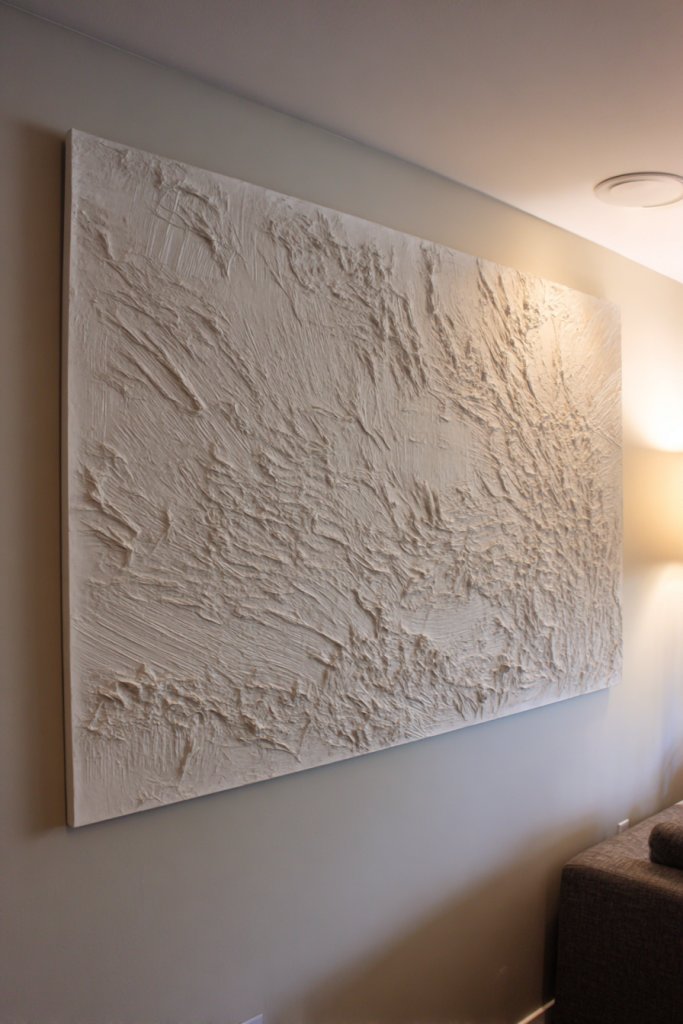
Want wall art that truly reflects your personality? DIY projects allow you to create customized pieces that are meaningful and affordable. It’s about adding a personal touch without relying on generic store-bought art. Ready to hang your own masterpiece?
Imagine a vibrant canvas print you painted yourself, perhaps with bold abstract strokes or a calming landscape. Or a quote stencil in a stylish font on textured paper framed simply. These pieces showcase your creativity and make your space uniquely yours. The art adds color, texture, and a sense of accomplishment, turning your wall into a conversation starter.
Use different mediums—acrylic paints, fabric, mixed media—to suit your style and skill level. Incorporate personal photos with painted backgrounds or create collages with magazine cutouts. Change your artwork seasonally or as your tastes evolve. Frame your DIY pieces in simple wood or metal for a polished look. Play with sizes and shapes for visual variety.
Gather your materials—canvas, paints, brushes, or printable designs. Plan your layout and select inspiring images or quotes. For painted art, sketch lightly before applying bold strokes. Use stencils or freehand techniques for quotes or abstract designs. Once dry, frame or mount your art using nails, hooks, or adhesive strips. Regularly update your gallery wall with new pieces to keep it fresh.
Add embellishments like metallic leaf, textured gels, or fabric overlays for extra depth. Incorporate favorite colors or themes that match your decor. Personalize with hand-lettered quotes or meaningful symbols. Use different framing styles—vintage, modern, or DIY frames—to match your aesthetic. Your wall art becomes a reflection of your personality and style.
Creating your own wall art empowers you and boosts your confidence in interior styling. It proves that you don’t need to spend a fortune to make a space look curated and personal. Every piece you craft adds a layer of authenticity and warmth. Your home becomes a gallery of your creativity and personality.
22. Layered Throws and Cushions for Comfort and Style
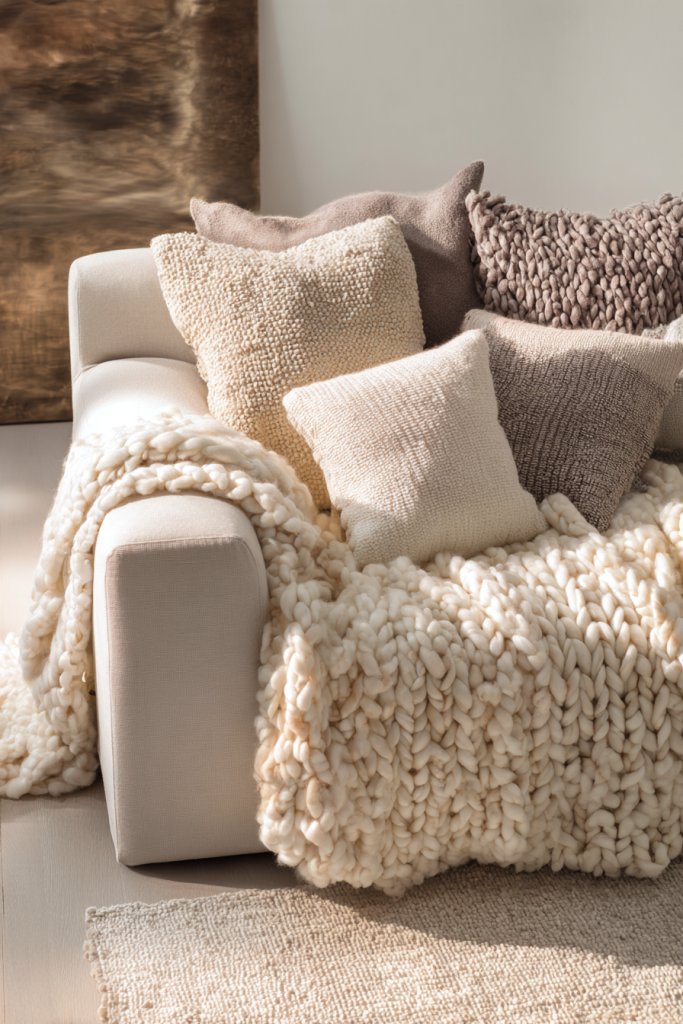
A living room that feels flat or uninviting can be transformed with well-chosen throws and cushions. Layering these elements adds comfort, color, and texture effortlessly. It’s the easiest way to make your space cozy and stylish at the same time. Want to invite relaxation?
Picture a sofa adorned with cushions in varying sizes, fabrics, and patterns—think velvet, linen, and woven textures—that complement a soft throw blanket draped casually over the arm. The layers create visual depth and invite you to sink in. The combination of colors and textures adds personality and warmth, making your living room feel like a curated retreat. The tactile appeal of the layered textiles encourages touch and relaxation.
Mix cushions with different textures, shapes, and sizes—square, round, or bolster—to add visual interest. Use throws in complementary or contrasting colors to create a balanced look. Change cushions seasonally or to match your decor updates. For a minimal look, stick to a cohesive color palette; for maximal impact, go bold with clashing patterns. Layering is about balance—avoid overcrowding or clashing.
Start with a base cushion in a neutral or primary color. Layer smaller cushions or decorative pillows on top, mixing textures and patterns. Drape throws over the sofa or chair, folding or loosely arranging for a relaxed vibe. Use cushions with removable covers for easy cleaning. Regularly rotate or swap cushions and throws to keep the look fresh. Complement your decor with textiles that feel good to the touch.
Create a signature look by choosing cushions and throws in your favorite colors or patterns. Incorporate textured or embroidered cushions for extra flair. Use cushions with personal embroidery or monograms for a custom touch. Add decorative accents like tassels, fringes, or metallic trims. These layers turn your furniture into a cozy, personalized haven.
Layered throws and cushions make your space instantly more inviting and stylish. They show your attention to detail and sense of comfort. When you see how a few cushions can change the vibe, your confidence in styling grows. It’s about creating a space that feels as good as it looks, every day.
23. Practical Use of Hidden Storage Ottomans or Poufs
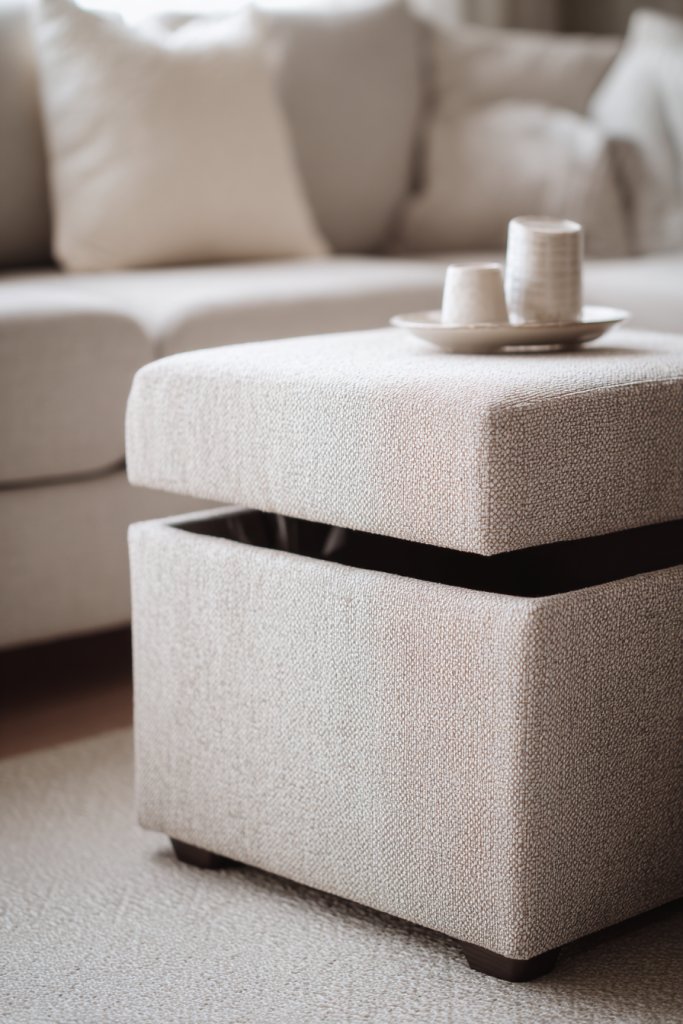
Living rooms often become dumping grounds for blankets, magazines, and remote controls. Hidden storage ottomans or poufs solve this by providing a place to stash items discreetly. It’s about combining function with style in a compact package. Who doesn’t love extra seating and storage in one?
Imagine a soft cream or textured fabric ottoman with a removable lid that reveals a spacious compartment. It doubles as a footrest or extra seating when guests arrive. The sleek design blends seamlessly with your sofa, adding a layer of sophistication. The hidden storage keeps clutter out of sight, making your space appear neat and inviting. Its understated elegance makes it a versatile piece.
Choose ottomans or poufs in fabrics that match or contrast your decor—think velvet for luxe, woven for boho, or leather for industrial. Use them as coffee table alternatives with a tray on top for drinks or decor. In small spaces, opt for multi-sized units that can be moved easily. For seasonal updates, change the covers or add decorative trims to match your mood or decor.
Select a size that fits your space and intended use—larger for seating, smaller for accent. Ensure the lid is sturdy and easy to lift. Place the ottoman centrally or near your seating for convenience. Use within arm’s reach for stored items, and regularly declutter. Cover or protect fabric with washable slipcovers for easy maintenance. Combine with other multifunctional furniture to maximize utility.
Add decorative trims, embroidery, or painted designs to your ottoman to match your decor. Incorporate textured or patterned fabrics for a custom look. Use decorative trays or small accessories on top to turn it into a mini coffee table. Personalize with initials or motifs that reflect your style. These pieces become a functional yet stylish signature element.
Practical storage ottomans show that you can have both style and function. They boost your confidence in choosing multi-use furniture that adapts to your lifestyle. When your space stays tidy and stylish, your home feels more welcoming and organized. It’s a small upgrade with a big impact on daily comfort.
24. Stylish Area Dividers Using Bookshelves or Curtain Tracks
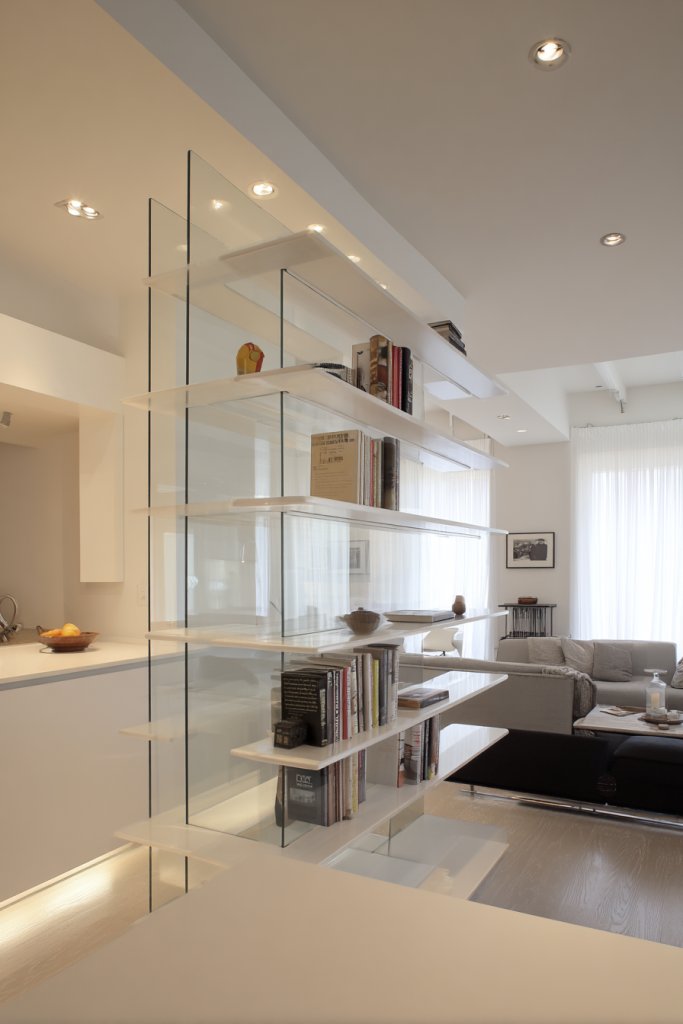
Open floor plans are great but can lack privacy or definition. Stylish area dividers help carve out zones without closing off your space entirely. They maintain a sense of flow while creating functional boundaries. Want to define your zones with style?
Imagine a tall bookshelf filled with books, baskets, and decorative objects acting as a room divider. Or a flowing curtain track with elegant fabric panels that can be drawn open or closed. These options add visual interest while serving a practical purpose. The bookshelf adds character, while curtains can soften the look and add texture. Both options define spaces without sacrificing natural light.
Choose open or closed shelving units in wood, metal, or glass to match your decor. Curtains in fabrics like linen, velvet, or patterned textiles add softness and style. Use decorative accessories, like baskets or vases, to make the divider a feature. Adjust the height and placement based on your room layout. For flexibility, opt for lightweight or foldable options that can be moved or stored easily.
Measure the space where the divider will go, considering doorways or pathways. Securely assemble or hang your chosen divider, ensuring stability. For bookshelves, organize items to create visual balance and interest—layer books with decorative objects. For curtains, install a sturdy track, and choose a fabric that complements your decor. Regularly dust and update accessories or fabric panels for a fresh look. Use the divider to create cozy zones or functional separation.
Decorate shelves with personal items—photos, collectibles, or themed decor—to add character. Choose curtain fabrics that match or contrast your room’s color scheme. Incorporate lighting—like fairy lights or sconces—around or behind the divider for ambiance. Personal touches make the divider a statement piece that reflects your personality. Change accessories seasonally for freshness.
Stylish dividers showcase your ability to create functional, beautiful spaces. They prove that open layouts can be both social and private. Mastering this technique boosts your confidence in designing flexible interiors. Every time you define a zone with style, you’re making your home more functional and personalized.
25. Personal Gallery Wall with Photos, Prints, and Unique Frames
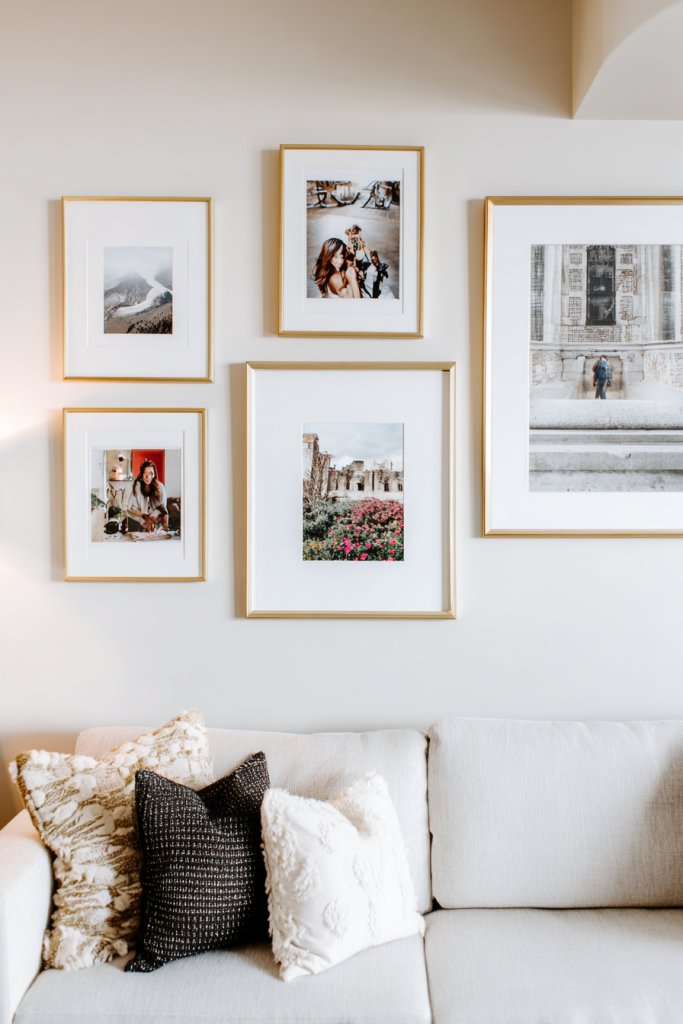
Blank walls can make your living room feel cold or unfinished. A personal gallery wall adds warmth, personality, and visual interest. It’s a way to showcase your memories, artwork, or favorite prints all in one place. Want a focal point that tells your story?
Imagine a wall filled with an eclectic mix of framed photos, prints, and artwork in various sizes and styles. Use a mix of matching and contrasting frames—metal, wood, or painted—to create a curated, layered look. Arrange the pieces in a grid, salon-style, or asymmetrically for a dynamic effect. The collection becomes a visual narrative that reflects your personality and aesthetic. The varied textures and frames catch light and add depth to the room.
Create a theme—family, travel, art—or mix everything for an eclectic look. Use different frame materials and finishes for visual interest. Incorporate personal photos, favorite quotes, or abstract prints. Change out pieces seasonally or periodically for freshness. Use hanging templates or painter’s tape to plan your layout before committing to nails or hooks. Keep some space between frames for a balanced look.
Gather your favorite images and select frames that match your decor style. Lay out the arrangement on the floor first, adjusting until you’re happy with the composition. Use a level and appropriate hooks or nails to hang each piece securely. For a professional look, consider framing your own prints or photos in custom mats. Regularly dust and reframe or update to keep the display lively. This personalized gallery becomes the heart of your living room.
Add decorative elements like small mirrors, textured mats, or fabric accents within your gallery. Incorporate memorabilia or artwork you’ve created for a more personal touch. Use themed collections—like travel souvenirs in shadow boxes—to tell a story. Mix in artwork with meaningful quotes or handwritten notes behind frames. Your gallery wall becomes a visual diary of your life and style.
A gallery wall shows off your personality and taste, making your home uniquely yours. It demonstrates your ability to curate and design with intention. Each new addition boosts your confidence in decorating and personal expression. Your walls become a dynamic, inspiring display of your life and creativity.
Conclusion
With a variety of design ideas showcased, you now have plenty of inspiration to refresh your apartment living room. Embrace these creative tips and personalize them to fit your style, turning your space into a cozy, stylish retreat. Dive into these ideas, get inspired, and start creating a living room that feels just right for you — because your perfect space is just a few inspired changes away!